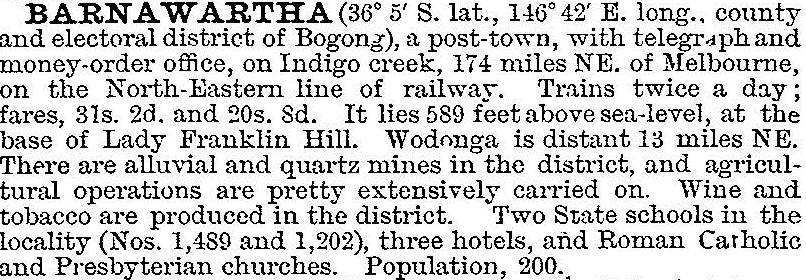Barnawartha
Barnawartha is a rural township on the Melbourne to Sydney road (Hume Highway) where it is crossed by the Indigo Creek. It is 20 km west of Wodonga in north-eastern Victoria.
In 1837 a pastoral run along much of the Indigo Creek was taken up and given a name similar to Barnawartha. It is thought that the name is derived from an Aboriginal word, variously recorded as meaning tall rushes, parting of the storms or deaf and dumb.
A settlement formed and was known for a short time as Indigo Crossing until replaced by the present name during the 1840s.
About five kilometres east of Barnawartha is Mount Lady Franklin, named after the wife of the Lieutenant Governor of Tasmania, Sir John Franklin. Lady Jane Franklin journeyed from Melbourne to Yass in 1839, and stopped near Barnawartha.
By the late 1850s Barnawartha had a Catholic school (1859) and two hotels. A flour mill was built in 1860. Barnawartha is east of the hilly, forested country of Chiltern, and has extensive open land suitable for grazing and cultivation north towards the Murray River. Cereals, fodder, potatoes and dairy goods were produced. A vineyard was begun in 1858, becoming Gehrigs Winery in 1867. Gehrig's ‘Barnawartha House’ homestead was built in 1870.
In 1903 the Australian handbook described Barnawartha as:

Barnawartha is on the railway line from Melbourne to Wodonga (1873). Its station was closed in 1985. In January 1952, a bushfire destroyed ten houses, a shop, an old mill and the Methodist church in Barnawartha.
About 7 km north-west is Barnawartha North, which is near Gehrig's winery and the historic homestead ‘The Hermitage’ (1852-54). Built from local granite, the homestead is on the Australian and Victorian historic buildings registers. Barnawartha North had a school from 1870 to 1961.
Barnawartha has a school (21 pupils, 2014), a hotel, a golf course, Anglican, Uniting and Catholic churches, a memorial hall (1921) and a recreation oval. Barnawatha’s Star Hotel was damaged by fire in 2006.
Its census populations have been:
| Census date | Population |
|---|---|
| 1861 | 20 |
| 1881 | 146 |
| 1891 | 196 |
| 1921 | 278 |
| 1966 | 190 |
| 1996 | 438 |
| 2006 | 518 |
| 2011 | 945 |
Further Reading
Susanne Pendlebury (co-ordinator), Historic Barnawartha, 1992


